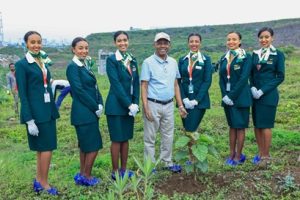
BY ADDISALEM MULAT
Forestry is one of the potential natural resources that can maximize the country’s economic benefit in multiples of ways. For instance the forest itself can generate income as tourist attraction as well as income through the sale of forest products. Furthermore it can generate income by serving as suitable habitat for wildlife which in turn brings about more economic benefits.
Despite the fact that Ethiopia’s huge, wide-ranging and richer tourism potentials take account of flora and fauna, a number of historical, cultural, religious and archeological attractions, tangible and intangible heritage, fauna and flora, and other related aspects, the government is not able to achieve the envisioned goal as expected.
In an earlier time, owing to degradation and other similar activities the forest coverage of the country was dwindling again and again. However, following Prime Minister Abiy’s initiative, Ethiopians all over the country were able to plant billions of trees, and thus the country is moving in the right direction and getting back on track.
In an interview, Professor Masresha Fetene gave to the Ethiopian Herald said, “The forest sector has been beseeched by many problems. The first problem has been the lack of reliable data on the forest resources of the country. The Woody Biomass Inventory Project of the 1990s was one of the first comprehensive sources of data. More recently, the FAO supported national forest inventory, completed in 2017, is providing relatively reliable data.
The outstanding problems have been the continued high rate of deforestation on the one hand, and the poor performance of national afforestation and rehabilitation efforts, on the other.
“The immediate causes of deforestation are high population growth with increasing demand for forest products, such as for fuel wood, charcoal and construction wood; expansion of agriculture and resettlement programs. More recently the expansion of large-scale farms, human-induced seasonal wildfires, and illegal harvesting of timber are exacerbating the problem,” he underlined.
In an interview, Professor Sebsebe Demisse gave to The Ethiopian Herald said, “Prior to 2015 what we considered as forests include moist montane forests mainly in SW Ethiopia and Harenna Forest in Bale and dry montane forests occurring in eastern, central, north-western, northern highlands.
The forest was defined as “Land spanning more than 0.5 hectares with trees higher than 5 meters and a canopy cover of more than 10 percent). As per this definition, the forest cover was about 3-4% and thereabout.
In the same way, Ethiopia is known for its unique wildlife resources that are situated in every nook and cranny of the country that demonstrates its distinctive features, endemism, and rareness. Though the country is inundated with various minerals, the desired goal has not been achieved.
“Ethiopia has a prospect of developing its own resource based chemical industry. Strengthening public-private-partnership (PPP) is one modality by which the Chemical industrial development strategy can be fostered” Dr. Eng. Abubeker Yimam, the dean of the School of Chemical and Bio-Engineering at Addis Ababa Institute of Technology, Addis Ababa University told The Ethiopian Herald.
Various incentives have been initiated including equities on joint ventures and access to credit. These should be strengthened and well rife. Investment promotion for both potential local and foreign investors on the opportunities (homegrown chemical products) should be undertaken.
As mentioned earlier, one of the benefits of protecting forestry is to protect the safety of wildlife which largely depends on it. The less attention given to the forestry sector is costing the country its benefit from wild life sector, too.
Despite the fact that the left, right, and center of the different regional states of the country consist of a number of wildlife resources, much attention has not been given to the wildlife resources of the Benishangul-Gumuz Regional State.
According to Negussu Delelegn, Diaspora Affairs Senior Expert, Benshangul-Gumuz Administrative Council, the Benishangul-Gumuz regional state is alienated by the Blue Nile River into two parts. The direction of Blue Nile set in motion by inflowing to the region from the east, turning then to the north-west and leaving it between Sherkole and Guba woreda towards Sudan.
According to the Benishangul-Gumuz Regional State-Investment Office-Resource Potential Project Identification Profile Preparation and Industrial Zone study, the wildlife potential of the region is endowed with abundant resources according to fragmented and reconnaissance studies carried out on the biotic resource potential of the region for the most part on the level of the three administrative zones: Asosa, Kamashi, and Metekel.
In the second survey which was carried out after sixteen years in 2000, the mammals observed in the same area were only 8 species and 64 species of birds being in short of 18 mammals and 60 bird species as compared to the first survey.
On the third survey of the wildlife resources that was carried out in 2002, the experts were able to identify only nine species of mammals including the footprint of a leopard. On top of that, fifty-seven species of birds had been witnessed.
The Ethiopian Herald December 12/2020




